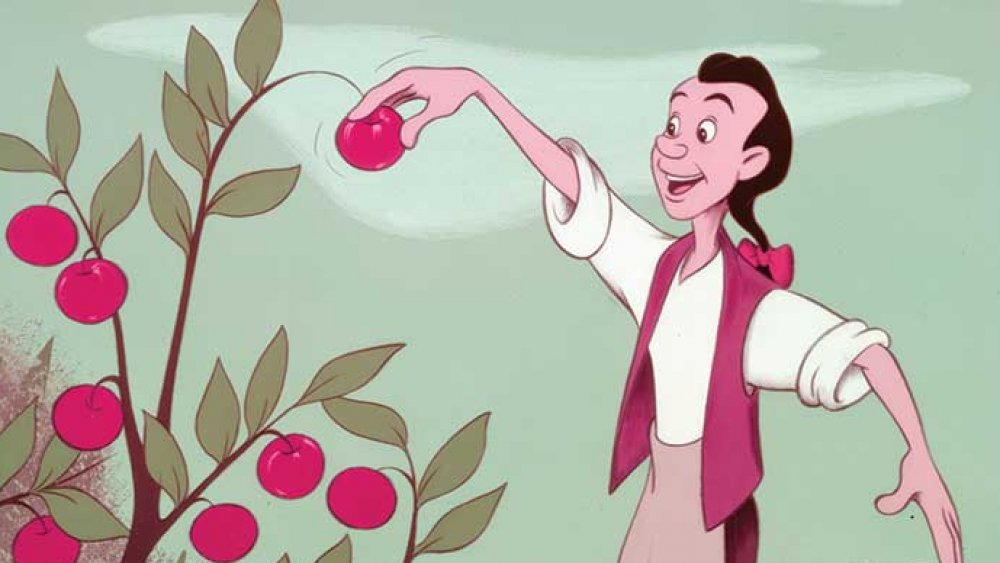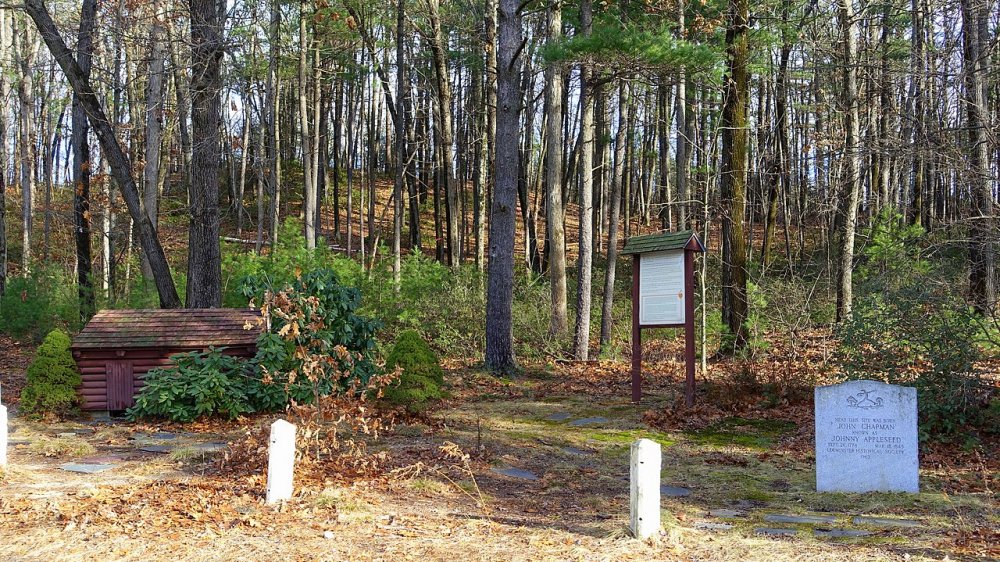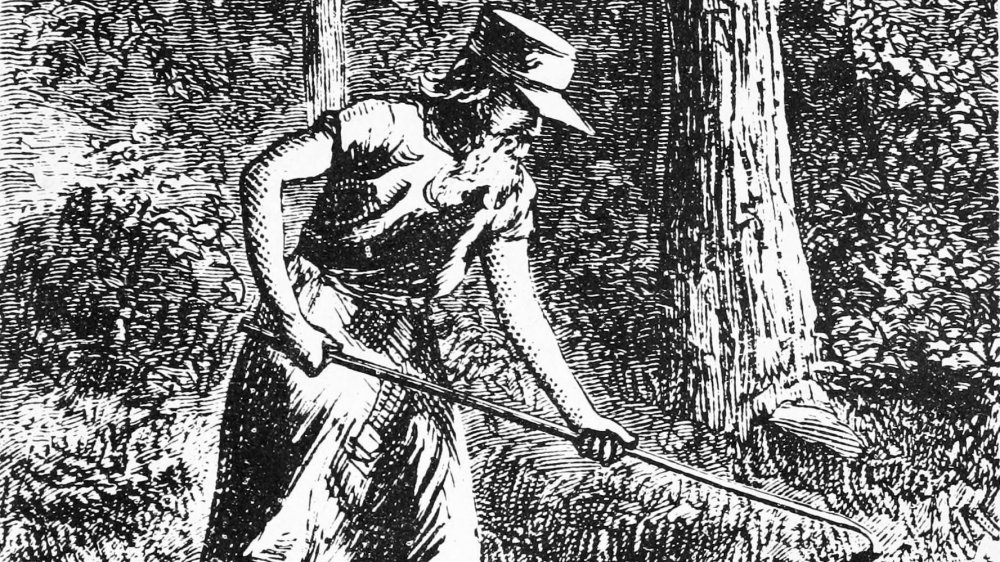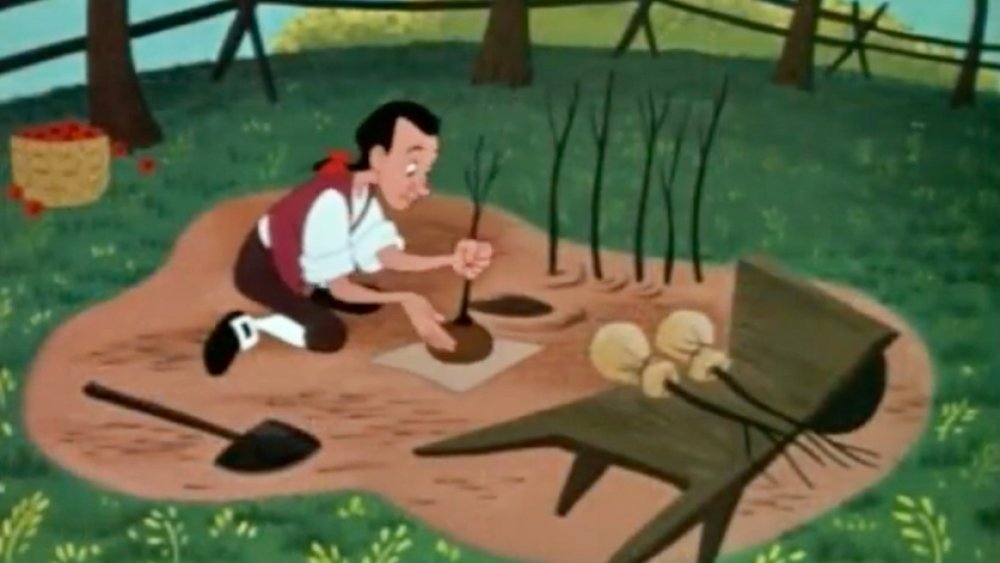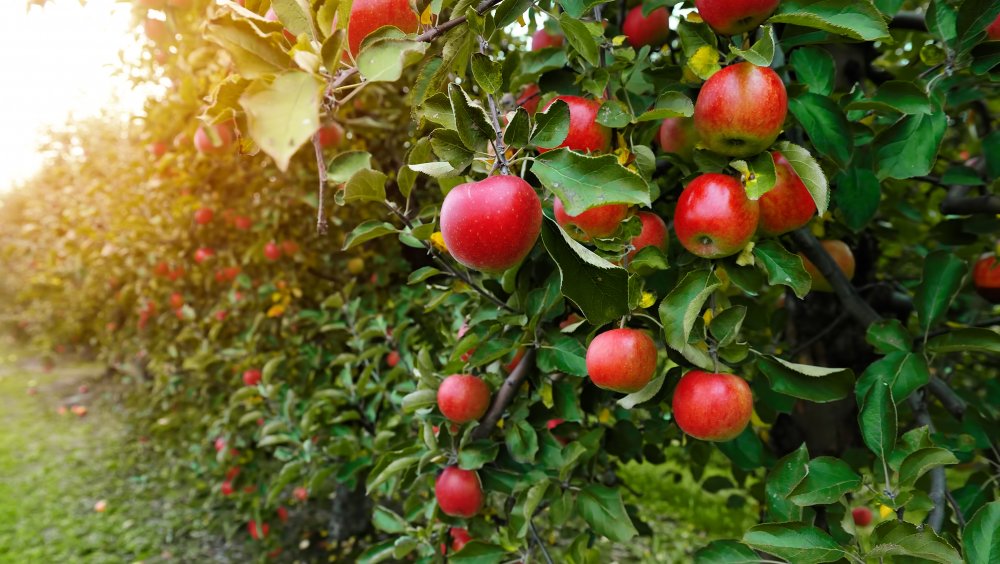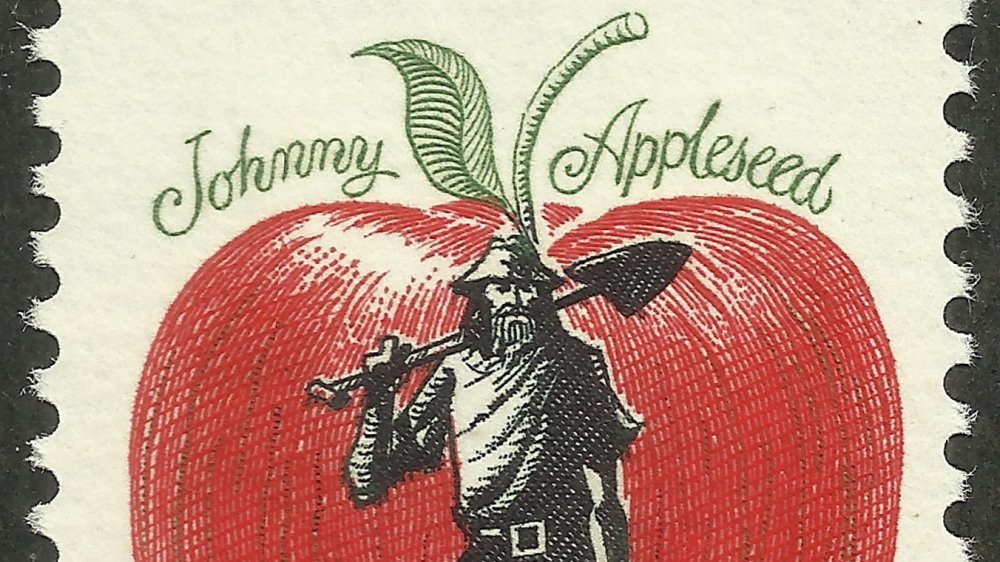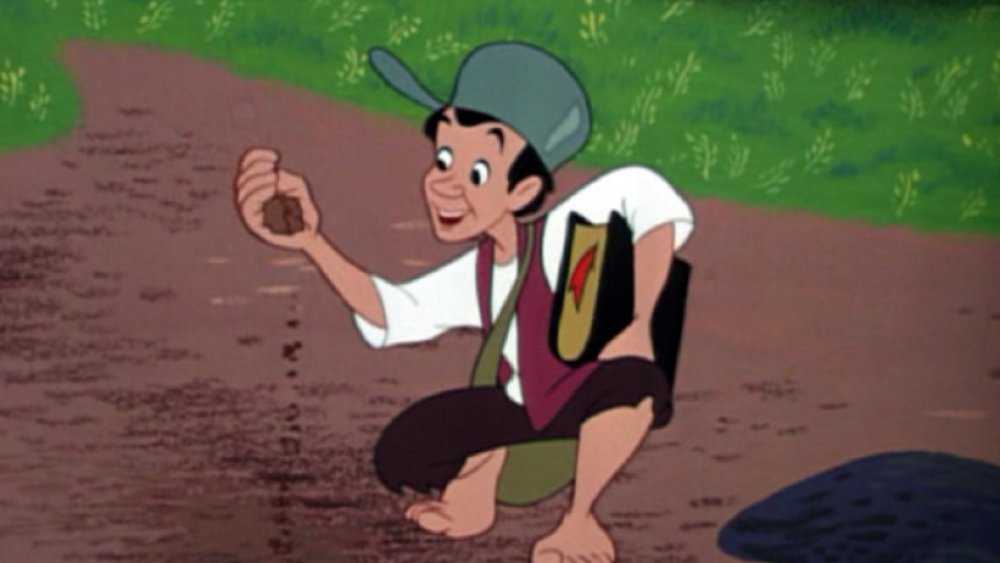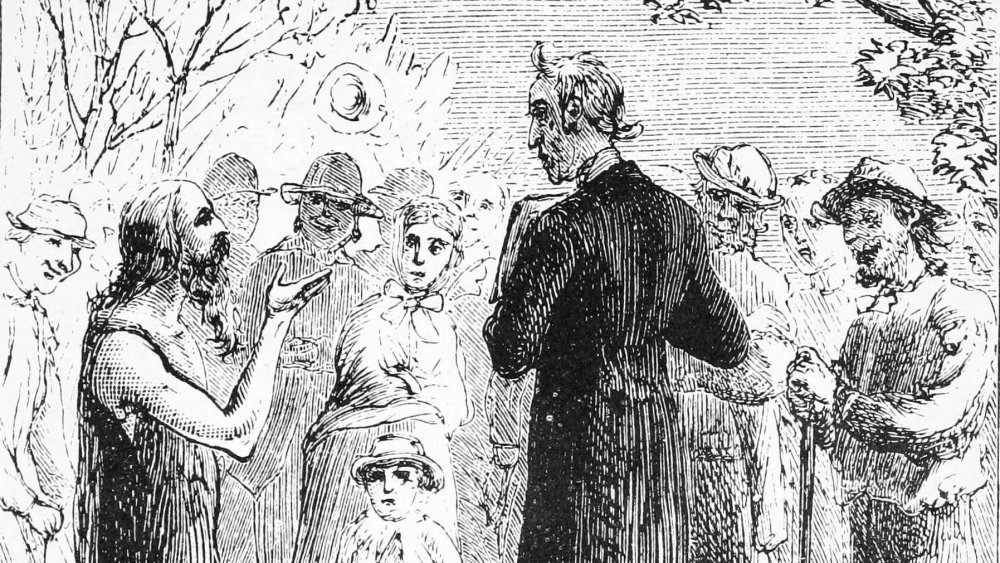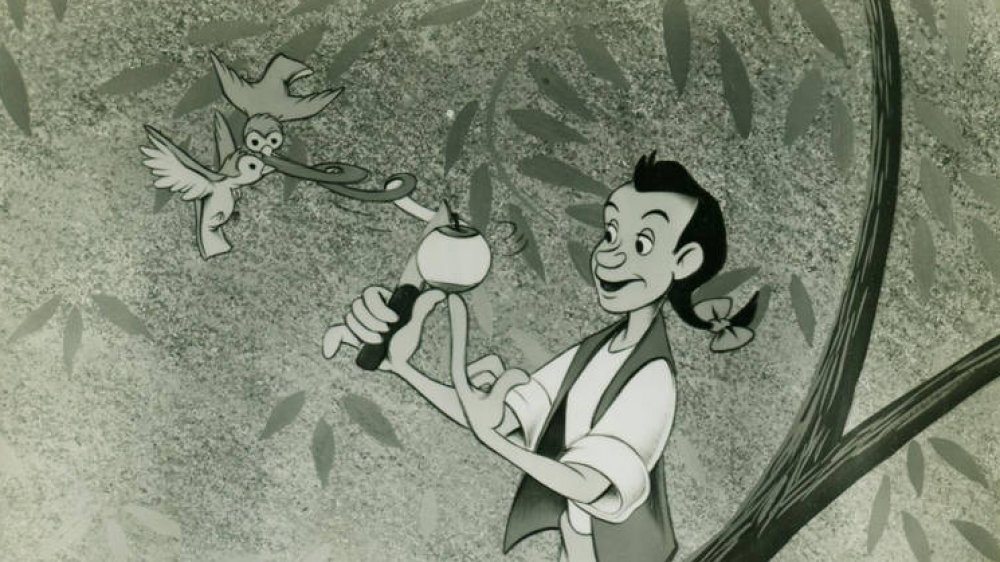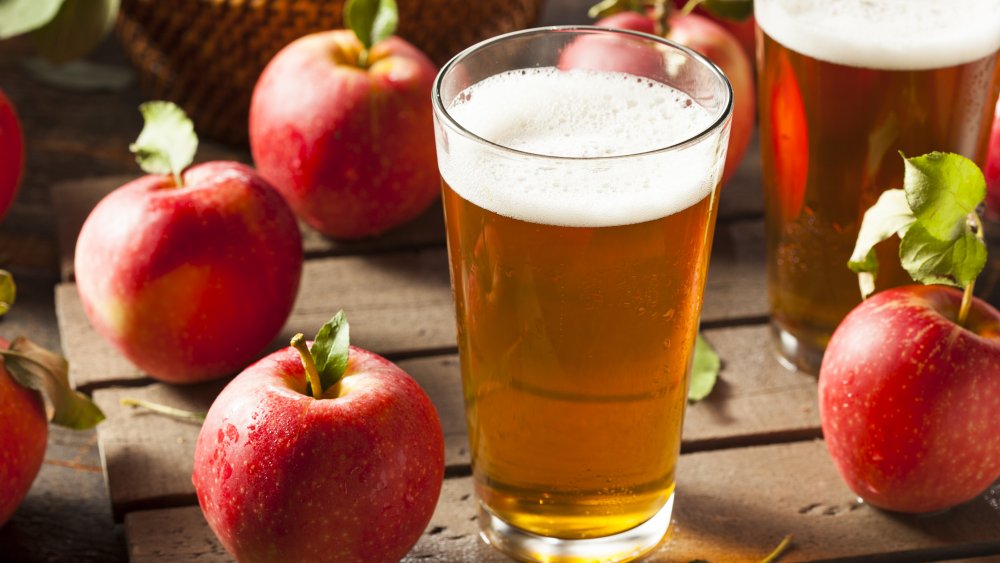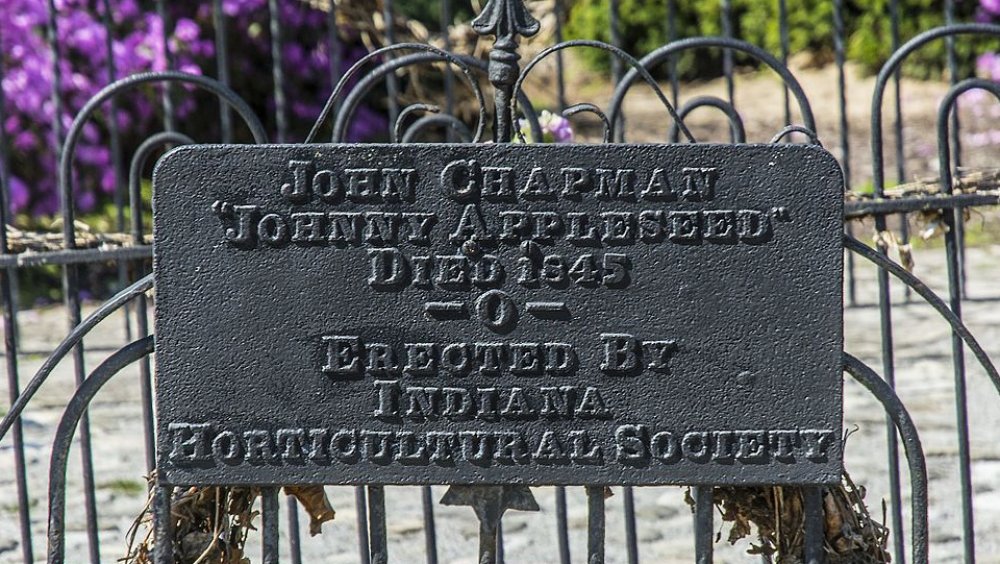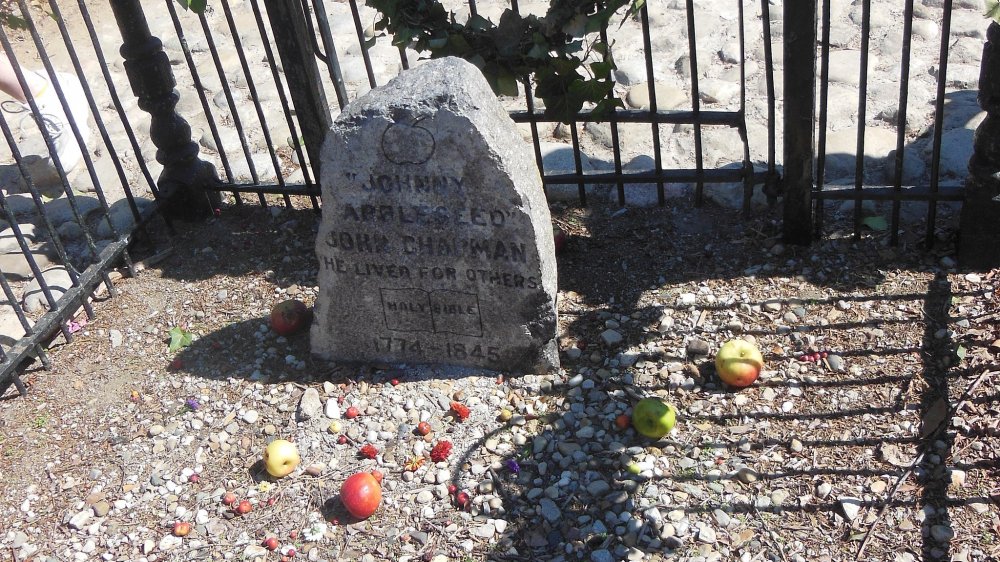The Truth About How Johnny Appleseed Became A Folk Hero
Most Americans are familiar with the legend of Johnny Appleseed, having read his story as children along with other folk heroes like Paul Bunyan and Daniel Boone. The image of Appleseed that has been planted in American minds is one of a barefoot wanderer, traversing the Wild West with just a sack of apples, a Bible, and tin pot on his head. While this version of the myth has persisted for well over a century, in 2001 Michael Pollen presented a new way to think of Johnny Appleseed: as "the American Dionysus."
While parts of the Johnny Appleseed myth are based in historical fact — he really did wear coffee sacks as clothing and walk around barefoot — there is much more to this folksy American legend than the storybook version allows. For starters, he was far from being a country bumpkin. Rather, Appleseed was a sharp and savvy land developer who used his business sense and planting proficiency to help settle land all across the Western frontier. He became a local legend when he was still alive, not only for his business skills or his eccentric reputation, but because he was bringing the one thing pioneers really wanted to the frontier: Alcohol.
The real Johnny Appleseed
Johnny Appleseed's real name was John Chapman, and he was born in Leominster, Massachusetts, on September 26, 1774, according to Biography. His father, Nathaniel, was a carpenter and a farmer who earned modest wages with which to support his wife, Elizabeth, and his children. Not long after Chapman's birth, his father joined up as a Minuteman in the Continental Army, serving under General George Washington. While his father was serving in the Revolutionary War in 1776, Chapman's mother contracted tuberculosis. Weakened by the disease, she died from complications giving birth to Chapman's younger brother. Tragically, the baby did not survive either.
Chapman and his older sister remained in the care of relatives until his father returned from war in 1780. He wasted no time finding another wife, marrying a woman named Lucy Cooley in the summer of that same year. According to the official Indiana state website, the newlyweds settled in Longmeadow, Massachusetts and proceeded to have 10 children together.
John Chapman travels West
In 1787, the Northwest Ordinance formally created the Northwest Territory, attracting a drove of pioneers heading West hoping to lay their claim to the new land. Also in 1787, Chapman's father arranged for him to begin an apprenticeship with a local orchardist named Mr. Crawford, according to Ohio History Central. It was there that Chapman began to learn the intricacies of planting and growing apples, including the many benefits of the versatility of the fruit.
In 1792, Chapman turned 18, and decided he had learned all he could about cultivating apples in an orchard. He figured it was time to take advantage of the exciting opportunities afforded to new settlers in the West, and took his planting skills on the road. He began travelling around Pennsylvania, Ohio, and New York with his 11-year-old half-brother, Nathaniel, per the Indiana State website.
The pair traveled around the Wilkes-Barre region for a period, before heading south to Virginia, then eventually back towards Pittsburgh, travelling north on the Allegheny River, according to American Heritage. Eventually, they made their way to southern Ohio, and the young Nathaniel decided that he was done with travels. In 1805, the elder Nathaniel moved his large brood west to meet them there. Chapman, however, wasn't content to stay in one place. Leaving the rest of him family to settle on the Ohio River, he continued west on his own.
John Chapman was a devout follower of Emanuel Swedenborg
John Chapman had an ulterior motive for his nomadic lifestyle. He was a devout member of the Church of Swedenborg, and saw himself as a religious missionary helping spread the word of Emanuel Swedenborg. Swedenborg was a Swedish scientist and theologian, who had a spiritual revelation in the 1740s that he believed brought about a new age of reason and truth. He taught that all of creation was divide in origin, and Earth's material planes corresponded to spiritual realities. To be saved, men needed to achieve unity between their spiritual and material selves by accepting the divine truth of Jesus Christ, per Britannica.
Chapman was one of the first new followers of Swedenborgianism in America. By the 1800s, he'd become a missionary, distributing Swedenborgian tracts and teaching as he traveled, per Oak Arbor Church. When families invited him to stay in their homes, he would ask: "Will you have some fresh news right from Heaven?" and proceed to preach the Swedenborgian gospel to them, per American Heritage
Swedenborgianism preached that all living things, including plants and animals, were divine creations of God. It was sinful to meddle with His perfect creations, so the Church of Swedenborg explicitly forbade the practice of grafting. Therefore, Chapman planted solely from seeds, but the only way to replicate the same variation of apples is through grafting old species onto new ones. Chapman's refusal to graft contributed to the development of hundreds of new apple varieties in the United States, per Paste Magazine.
Johnny's apples weren't for eating
"Apples don't 'come true' from seeds," Michael Pollen explains in his book The Botany of Desire (via the New York Times.) "An apple tree grown from a seed will be a wildling bearing little resemblance to its parent." Grafting is the only way to produce the sweet, edible apples like the ones found in grocery stores today. However, grafting is also very time and labor consuming process, and on the Western frontier, it didn't make a whole lot of economical sense.
The seeds Chapman planted produced apple varies that were sour, mealy, and just plain inedible. But they were never meant to be eaten. Chapman was beloved because he provided one essential commodity to the settlers of the Western frontier: Hard apple cider.
Water on the frontier was often full of bacteria and unfit for drinking. Hard cider, produced by fermenting the juice in barrels, provided a safe drinking source for pioneers out West. It took the place of most other beverages, including water, coffee, and tea. Frontiersman drank about "10.52 ounces of hard cider per day," according to Smithsonian Magazine. Apples could also be distilled into other frontier favorites, like brandy or the much stronger applejack. In fact, most apples that were grown in the 1800s were cultivated for the purpose of turning them into alcoholic beverages. It wasn't until after Prohibition that eating apples became a mainstay of the American diet, per Straight Dope.
John Chapman was a savvy businessman
John Chapman didn't just scatter seeds wherever the wind took them. Instead, he followed a strategic business plan, planting nurseries at busy outposts where he knew he could sell apples to incoming frontiersman. He planted his very first apple nursery in the spring of 1798, just off the Allegheny River, near what is now Warren, Pennsylvania, according to Straight Dope. From there, he traveled around Ohio, planting apple nurseries up and down the tributaries of the Muskingum River.
With the opening up of the West, a surge of new settlers were arriving to claim the land. Chapman would arrive first, planting apple trees every spring on available plots of land. Two or three autumns later, Chapman would have brand-new thriving apple trees to sell to the arriving settlers, who were only too happy to have immediate access to the cider the apple trees provided.
While Chapman made the bulk of his money from planting apples, he also planted medicinal herbs. He was responsible for bringing dogfennel, once believed to cure malaria, but now considered an invasive weed, to the Ohio area. Native Ohioans still refer to the plant as "Johnnyweed" today, according to Record Herald.
Johnny Appleseed was 'a shrewd real estate developer'
John Chapman was less of a whimsical farmer and more of a "shrewd real estate developer," according to Michael Pollen, via Straight Dope. According to frontier law, land in the West was open to anyone who arrived to develop it into a permanent homestead. And one of the main ways to develop the land was to plant trees on it.
According to History Daily, by planting the minimum of 50 apple trees, Chapman was effectively claiming the land. When frontiersman passed through the land, Chapman could sell the already developed land tracts directly to incoming settlers.
Chapman had a remarkable talent for predicting what land would be most attractive to new settlers. He would clear out patches, frequently near rivers, plant his apple trees, and protect every nursery with fences to keep out wildlife, well before the first parties of settlers ever arrived. According to Indiana's state website, he would eventually travel from Ohio and Pennsylvania to states as far as Kentucky, Illinois, and Indiana, cultivating land and selling land tracts to pioneers, paving the Western frontier with apple trees along the way.
Johnny Appleseed was the 'Yankee Saint'
While he was a savvy businessman, John Chapman's reputation was less of a shark and more of a gentle, benevolent spirit. According to Kerrigan, settlers "recognized Chapman as of New England origin, but he fit only imperfectly into the archetype of the Yankee peddlers ... He possessed Yankee thrift and sometimes Yankee ingenuity, but lacked the shrewdness and ambition typically associated with the nineteenth-century Yankee stereotype." Instead, most recollected him as something of a "Yankee saint."
According to Britannica, Chapman fully embraced the Swedenborgian doctrine that "the life of religion is to do good." He treated all living things with utmost respect. He maintained a strict vegetarian diet, believing it was a sin to harm any plants or animals. He was known to trade for food or clothing with families that could not afford to buy his apples outright, even giving away trees to truly needy settlers, according to the Indiana State website. Chapman was also as welcome and respected among Native American tribes as he was with white settlers, sometimes even serving as a peacemaker between the two.
None of this was common for rough and rugged frontiersmen, but his behavior only seemed to endear him to his fellow pioneers. According to Harper's, "It is the testimony of all that knew him that, notwithstanding his ridiculous attire, he was always treated with the greatest respect by the ruddiest frontiers-man; and, what is a better test, the boys of the settlements forbore to jeer at him."
Johnny Appleseed was an eccentric nomad
John Chapman never settled down, but not because he didn't have the option. By the time he died, he owned over 1,200 acres of land, according to History Daily. In fact, he accumulated a sizable amount of wealth in his lifetime, but no one would know it from looking at him. Despite his sharp business acumen, Chapman was an eccentric character. He wandered over 100,000 square miles of land in his lifetime, mostly on foot, per America's Library. This was made even more impressive by the fact that he frequently refused to wear shoes, so his feet were tough, gnarled and calloused.
According to American Heritage, Chapman usually wore just a simple cloth coffee sack. If he wore clothing at all, they were discarded garments, or used, oversized smocks and ill-fitting coats that he received via bartering in exchange for some of his apple seeds. His only accessory was a leather sack, which was filled with apple seeds he gathered from his orchards in Allegheny county every fall, per Straight Dope.
Personal quirks aside, perhaps the main reason he remained nomadic his whole life is simply because his business depended on it. The source of his success was his ability to predict where pioneers were likely to settle, and then beat them there, establishing his nurseries before they arrived. That kind of lifestyle does not easily lend itself to settled domesticity.
Johnny Appleseed was a local legend
In March of 1845, Indiana's Fort Wayne Sentinel printed an obituary for a "nurseryman" who "was well known through this region by his eccentricity and the strange garb he usually wore ... and has been a regular visitor here upwards of twenty years," per Kerrigan.
Well before his death, Chapman was already a well-known local legend. He had begun referring to himself as "Johnny Appleseed" by 1806. Settlers welcomed him not only because of his generosity or kind spirit, but because he had become something of a local celebrity. The legend went national with the publication of a Harper's magazine profile on "Johnny Appleseed" in 1871. Even 26 years after his death, interest in Chapman's story had not waned.
According to one story recounted in Harper's, "A settler who happened to possess a pair of shoes that were too small for his own use forced their acceptance on Johnny ... A few days afterwards the donor... met his beneficiary contentedly plodding along with his feet bare and half frozen. With some degree of anger, he inquired for the cause of such foolish conduct and received for a reply that Johnny had overtaken a poor, barefooted family moving westward, and as they appeared to be in much greater need of clothing than he was, he had given them the shoes." Whether or not the story is true, it illustrates Chapman had already been cemented in memory as a generous, if somewhat eccentric, man.
The FBI almost destroyed Chapman's legacy
By the 1920s, American's love affair with fermented beverages had soured. The connection to alcohol was slowly being scrubbed from Chapman's legacy, and replaced with the sanitized image of a folk hero who carried, instead of seeds, a sack of sweet red snacking apples.
And when Prohibition reached its full height, any traces of alcohol were erased from Chapman's former land plots. According to Smithsonian Magazine, the FBI was tasked with destroying trees that were used primarily for the production of alcohol. Unfortunately, that meant chopping down most of the trees Chapman had planted, which produced the small, bitter apples that were ideal only for fermenting into cider.
With Prohibition, the images of apples as the primary ingredient in alcoholic beverages, disappeared, along with most of Chapman's apple orchards. Instead, apples began to be marketed as a healthy snack. The fruit, and Johnny Appleseed along with them, took on the more wholesome image they still have today.
John Chapman lived to be 70-years-old
One chilly March day in 1845, John Chapman received news that cattle had destroyed some of the fencing around one of his nurseries some 20 miles away from Fort Wayne, Indiana, where he was staying with a friend, William Worth, according to the Indiana state website. He made the long trek to repair the fence, and arrived safely back to the Worth home. However, along the way, he had contracted what was then known as "the winter plague," but was most likely pneumonia. On the evening of March 18th, 1845, Chapman ate a simple dinner of bread and milk, read his Bible, went to sleep on the floor of the Worth home, and was dead by morning. He was 70-years-old.
Chapman never married, nor had any children. He remained chaste his whole life, declaring he would find a "pure wife in heaven," per American Heritage. But his legacy lives on in another way. Per Food and Wine, one of Johnny Appleseed's original apple trees still survives on a farm in Nova, Ohio. It is over 170-years-old.
According to NPR, the headstone in Fort Wayne memorializing his death reads simply: "He lived for others."
Johnny Appleseed became an American folk hero
After his death, sporadic accounts of Chapman's life popped up, written by people who knew him. Rosella Rice recounted meeting him as a little girl in various county histories of central Ohio in the 1860s. In 1881, Massachusetts poet Lydia Maria Child published the poem "Apple-Seed John," praising Chapman's frugality and generosity, in St. Nicholas magazine. W. D. Haley's 1871 profile in Harper's magazine took Chapman's fame national, but it wasn't until the 1880s that the bits and pieces of his life really began to take shape, according to Kerrigan. By then, Chapman became more myth than man.
Disney's 1948 film Melody Time solidified Chapman's image as the carefree, cheerful wanderer with a tin pot on his head and a bag full of sweet, juicy apples. Stories of the famous "Johnny Appleseed," had been circulating in American folklore for years, but most factual details of Chapman's life were not widely known until well into the twentieth century.
During the Cold War, patriotism sparked a renewed interest in American civic heroes. In 1950, the historian Robert Price, with researcher Carlos Burr Dawes, published the first thoroughly researched historical account of Chapman's life, Johnny Appleseed: Man and Myth. More scholarly accounts of Chapman's life followed, but he remains most famous as the American folk legend known as Johnny Appleseed. Both Indiana and Massachusetts claim Chapman as their own local hero. Fort Wayne hosts an annual Appleseed fest every year, while Chapman is Massachusetts' official folk hero, per Biography.
